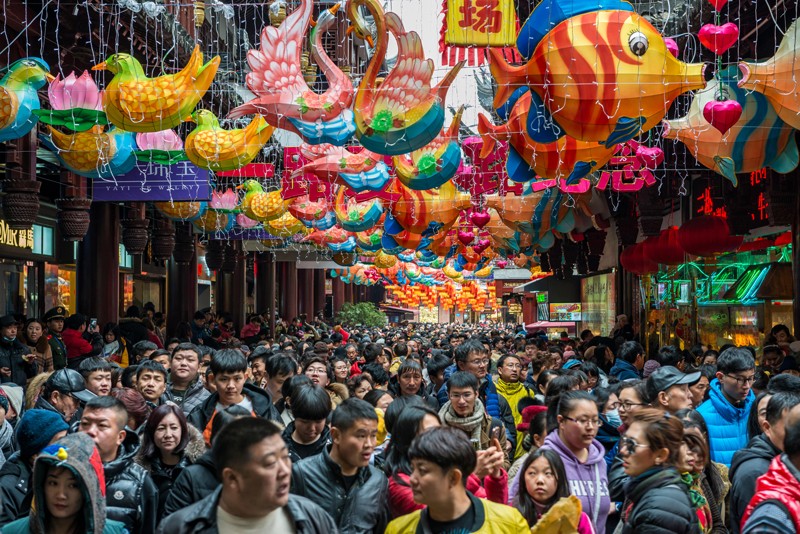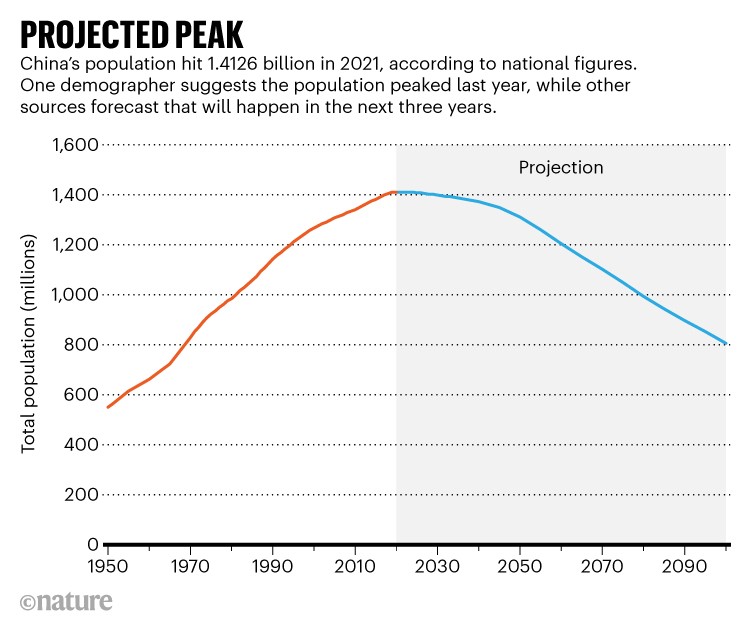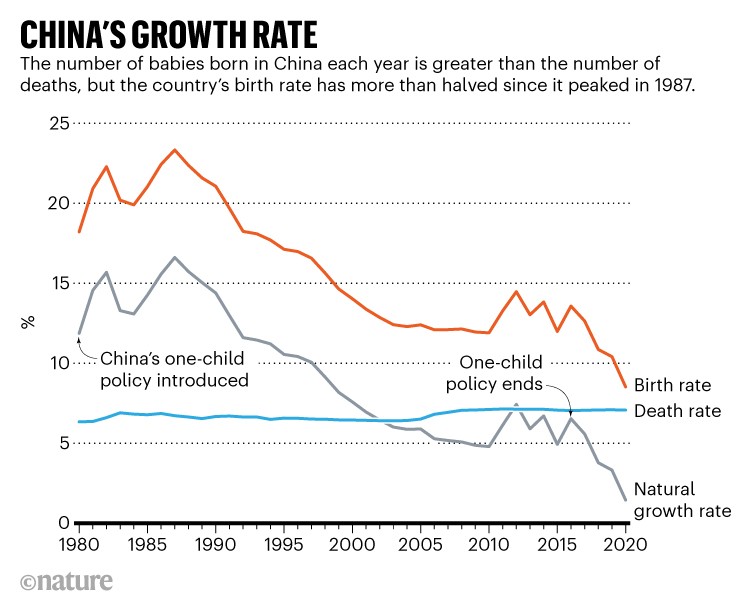When will China’s population, the world’s largest, peak? It’s a point that demographers say is fast approaching. The country’s health department announced this month that the population will peak and then begin to shrink in the next three years. Others think it could happen much sooner.
“The turning point is right around the corner,” says Yong Cai, a demographer at the University of North Carolina, Chapel Hill. “I won’t be surprised if population decline is reported at the end of this year.”
After years of falling birth rates, the National Health Commission wrote in an article published online in early August that China’s population growth has slowed significantly and will start to decline between 2023 and 2025. According to an estimate published last month in a peer-reviewed Chinese journal, Social Science Journal1, Wei Chen, a demographer at Renmin University in Beijing, concluded that, on the basis of national census data released in 2020, China’s population might have already peaked in 2021 (see ‘Projected peak’).
The Chinese government has made significant efforts to boost birth rates in the past decade, including reversing the country’s decades-long population-control policy. Demographers say a shifting attitude towards parenthood among younger generations is also contributing to slowed growth. The trend is likely to persist, and ageing will become a major challenge for the country, they say.
Last year, China’s total population increased by only 480,000 people, to just more than 1.41 billion, with a natural growth rate — the difference between the numbers of births and deaths — of close to zero. The country’s birth rate declined for the fifth consecutive year to 7.5 births per thousand people, and only 10 million babies were born in 2021, the lowest since 1949.
Shift in attitude
Table of Contents
In the 1960s, China saw a major baby boom after the Great Chinese Famine. In a bid to limit rapid population growth, the government launched a one-child policy in 1980 that restricted most families to having only a single child. The strategy brought down the country’s population growth rate, which dropped from 2.5% in 1970 to 0.7% in 2000. But the policy did not end until 2016 (see ‘China’s growth rate’). Many demographers, including Jianxin Li at Peking University in Beijing, think the policy ending came too late to reverse the country’s crashing fertility rate. Li projected as early as 1997 that China’s population could peak in 2024 if the population-control policy remained in place.
Researchers say China’s falling birth rate has continued even after the one-child policy ended because of shifting attitudes towards marriage and childbearing and young people delaying these events. With more women pursuing higher education and taking on paid jobs, they are starting families later in life than previous generations, says Jian Song, a demographer at the Renmin University of China in Beijing.
Data show that, in 2020, the average age of men and women at their first marriage was around 29 and 28 years old, respectively. In 2010, women were 24 years old and men were 26 when entering their first marriage. In China, most people choose to have children after they’re married, and having children later in life means that women tend to have fewer children, Song adds.
Younger generations tend to enter marriage and childbearing more carefully, once they are financially prepared, says Yang Shen, a sociologist at Shanghai Jiao Tong University in China. “Most young people today still want to have a family, but economic pressure from housing and childcare can seriously deter them from doing so,” Shen says.
Research has found that 45% fewer babies were born in the last two months of 2020 than the same period in 2015, suggesting the COVID-19 outbreak, which hit China in early 2020, affected couples’ decisions on whether to have children.
Ageing society
China’s “tsunami of falling birth rate” is exacerbated by the smaller number of women entering childbearing age, Cai says. The number of babies born in the 1990s was much smaller than in the 1980s. That generation of women is now at childbearing age, but will have fewer children in total than the previous generation. “Demographically, there is a strong negative momentum,” Cai says.
At the same time, the baby boomers born in the 1960s are reaching their 60s. “In the next 10 to 20 years, China will see a surge in its older population, which will become a major challenge for the society,” Song says. Currently, more than 18% of China’s population is over 60 years old. The proportion is expected to increase to one-third by 2050, reaching 300 million people.
An ageing population is an expense for families and a fiscal problem for the government. Cai’s team has projected that public spending on health care will double between 2015 and 2050 because of population ageing. “We have to start preparing resources needed to take care of the older population now to cope with the ageing challenge,” Song says.



